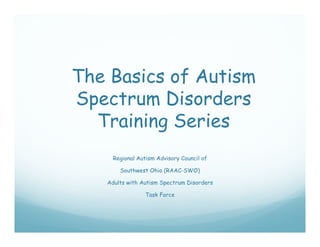Autism 007
- 1. The Basics of Autism Spectrum Disorders p Training Series Regional Autism Advisory Council of Southwest Ohio (RAAC SWO) (RAAC-SWO) Adults with Autism Spectrum Disorders Task Force
- 2. Adult Training S i M d l Ad lt T i i Series Modules Module One: Autism Defined, Autism Prevalence and Primary Characteristics m y Module Two: Physical Characteristics of Autism Module Three: Cognition and Learning in Autism Module Four: Autism and Sensory Differences Module Five: Communication and Autism
- 3. Adult Training S i M d l Ad lt T i i Series Modules Module Six: Behavior Challenges and Autism Module Seven: Understanding Behavior in g Persons with Autism P h Module Eight: Functional Behavior Assessment Module Nine: Autism and Leisure Skills to Teach Module Ten: Special Issues of Adolescence and p f Adulthood Module Eleven: Safety and Autism
- 4. Big Idea We must first understand why a behavior occurs y before we are able to change it. h
- 5. Steps to Understanding Reasons for Behavior
- 6. Step One: Describe What Was Happening Before the Behavior Started Who, What, When, Where, and then Why? Where does the behavior happen? When does the behavior happen? Who is there when the behavior occurs? What Wh t was hhappening right b f i i ht before the th behavior started?
- 7. Step Two: D Describe th Behavior ib the B h i Describe the behavior exactly exactly. What did it look like (as if you had a y video camera)? Who was involved? How long did it last? g What was being said?
- 8. Step Three: What Happened Immediately Following the Behavior? What happened to end the behavior? What did the person do? Was someone else involved in ending the behavior? Did the person get what he wanted? What was it?
- 9. Big Idea All behavior happens for a reason and it is motivated by something.
- 10. Some Reasons Behind Behavior Behaviors are a way of coping with what is happening B h i f i ith h t i h i around us. Behaviors are l B h i learned through trial and error. d h h i l d Behaviors that are reinforced are likely to continue. If a behavior continues to occur or it is increasing, it is being reinforced in some way. To change the personâs behavior, we must change what we are doing.
- 11. Reinforcement Reinforcement is something that f f g follows a behavior that either makes it occur more often or less often. Examples: a baby says âmamaâ for the first time and mommy smiles, claps, and yells her excitement. (Positive) a teenager comes home past curfew and the parent grounds the teenager for two weeks. (Negative) I receive a paycheck every 2 weeks. (Positive)
- 12. Reinforcement is Important We all reinforce ourselves throughout the day. f g y (i.e. an ice cream cone, a break, a favorite television show, praise) ,p ) Persons with ASD tend to need a lot of reinforcement throughout their day. f m ug u y. - It increases motivation to participate. - Participation can help in learning new things. - Once the behavior is learned, the reinforcement can usually be lessened.
- 13. Big Bi Idea Everyoneâs reinforcers are y different. We have to find out what works for each p person.












